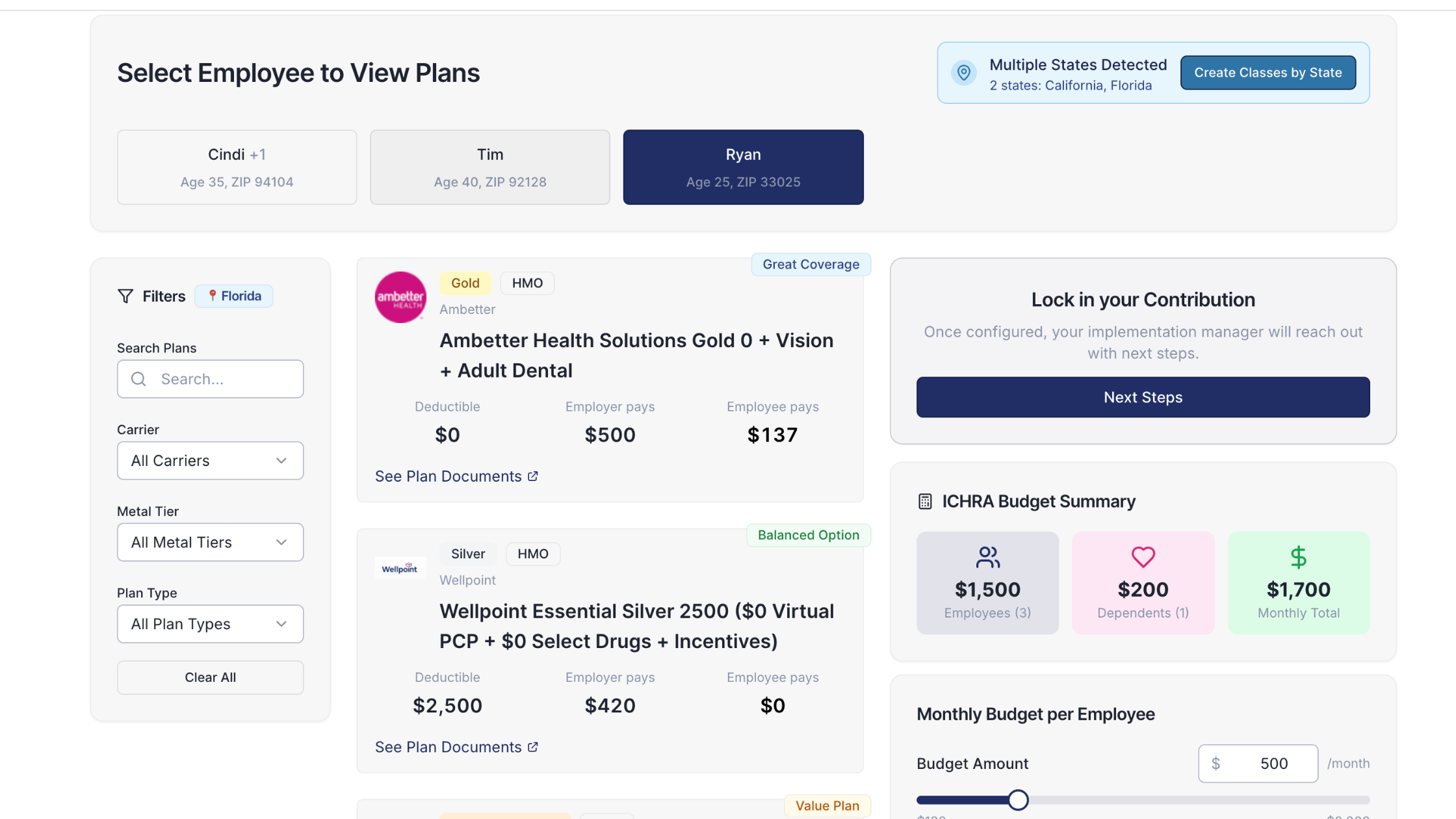Demystifying ICHRA Classes: A Comprehensive Guide to Minimum Class Requirements

Picture this: your company has various divisions, each with employees who have unique needs. This is where ICHRA classes come into play. They allow you to customize benefits based on employee characteristics such as full-time or part-time status, location, and more.
Understanding the Mechanics of ICHRA Classes
By segmenting your employees into different classes, you can ensure that each group receives the appropriate benefits, creating a sense of fairness and equity within your organization. You may have a class specifically for full-time employees, another for part-time employees, and yet another for remote or distributed team members. This flexibility ensures that everyone gets the benefits tailored to their circumstances, creating a win-win situation.
The Scope of ICHRA Employee Classes
ICHRA offers a framework of 11 distinct employee classes, providing a comprehensive method to categorize your workforce. This setup not only includes the more common classifications like full-time and part-time employees but also extends to unique categories such as seasonal and remote workers. Understanding each class's specifics is crucial for tailoring your benefits offerings effectively.
Example ICHRA classes include:
- Full-Time Employees: This class includes employees who work a standard 40-hour workweek. They are eligible for a comprehensive benefits package that covers healthcare, dental, vision, and more.
- Part-Time Employees: This class caters to employees who work less than the standard 40 hours per week. While they may have reduced hours, they still deserve access to essential benefits. The part-time employee class ensures they receive a scaled-down version of the full-time benefits package.
- Geography: In today's digital age, many companies have employees who work remotely or are part of a distributed team. This class recognizes their unique work arrangement and provides benefits that accommodate their specific needs based on their geography.
By leveraging these classifications, you can enhance your understanding of your workforce's diverse needs and craft a benefits strategy that is both inclusive and effective.
Understanding the 11 ICHRA Employee Classes and Their Importance
Navigating the intricacies of setting up an Individual Coverage Health Reimbursement Arrangement (ICHRA) involves understanding the diverse employee classes. These classes help employers tailor health benefits to meet the varied needs of their workforce. Here’s an insightful breakdown of these 11 classes and the key role they play:
- Full-Time Employees: Typically defined by the employer in terms of hours worked per week. Offering benefits to this group ensures coverage for your core workforce.
- Part-Time Employees: Employees with fewer hours than their full-time counterparts. Customizing benefits for them can enhance retention and satisfaction.
- Seasonal Employees: Workers hired for specific periods, such as during holidays or peak seasons. Providing tailored benefits helps manage workforce dynamics and morale.
- Salaried Employees: Those on a fixed salary rather than hourly wages. Differentiating benefits by salary structure ensures fair compensation.
- Hourly Employees: Paid based on hours worked, often with variable schedules. Offering flexible benefits can address their unique needs.
- Employees Covered by a Collective Bargaining Agreement: Typically unionized workers, whose terms are negotiated through agreements. Ensuring compliance with these agreements is essential for legal and operational harmony.
- Temporary Employees: Usually hired through an agency or on a short-term basis. Crafting specific benefits can ensure temporary staff remain engaged and productive.
- Non-Resident Aliens with No U.S.-Based Income: These are typically foreign employees who work outside the U.S. Excluding or customizing their benefits as per ICHRA rules is crucial due to different tax implications.
- Employees in Different Geographic Locations: For companies that operate in multiple states or countries, benefits may need to differ according to regional laws and cost-of-living variations.
- Leased Employees: Individuals provided by a staffing firm for a specific role. Like temporary employees, this group often requires specialized benefit options.
- Waiting-Period Employees: New hires not yet eligible for benefits until a certain period has lapsed. Clearly communicating and managing this class is key to maintaining new hire satisfaction.
Why Are These Classes Significant?
Tailoring benefits according to these specific classes allows businesses to offer competitive and appropriate health coverage while adhering to legal requirements. Understanding each class also aids in strategic workforce planning and boosts overall employee satisfaction and retention by meeting diverse needs effectively.
By categorizing employees thoughtfully, businesses can maintain a more engaged, loyal, and productive workforce, ultimately contributing to organizational success.
Maximizing Cost Efficiency and Employee Benefits with ICHRA
If you're seeking a way to optimize your company's health benefits without breaking the bank, the Individual Coverage Health Reimbursement Arrangement (ICHRA) may be the answer. Here's how ICHRA can enhance cost efficiency while providing valuable health benefits to your team.
Understanding ICHRA
ICHRA allows employers to reimburse their employees for individual health insurance premiums and qualified medical expenses. This approach offers flexibility as employees can choose plans that best suit their needs and preferences.
Steps to Achieve Cost Efficiency
- Assess Your Budget: Determine the amount your business can allocate toward health benefits. ICHRA enables you to set defined contributions, controlling your financial responsibility.
- Tailor Employee Packages: Personalize the reimbursement amounts based on employee classes. This means you can allocate different reimbursement levels depending on factors such as job role or location, optimizing spending.
- Streamline Administration: Since employees choose their own plans, it reduces the administrative burden on your HR team. Outsourcing plan selection to employees means fewer in-house resources are required.
Enhancing Employee Satisfaction
- Customized Coverage: Employees appreciate having the freedom to select insurance plans that cater to their own needs. This personalization boosts their satisfaction and engagement.
- Tax Advantages: Both employers and employees can benefit from ICHRA's tax-free reimbursements, which potentially increases employees' take-home pay.
- Flexibility Equals Retention: Offering flexible and personalized health benefits can lead to higher employee retention, attracting talent who value such initiatives.
By strategically implementing ICHRA, your organization can strike a balance between cost containment and offering a competitive benefits package. Adopting this approach not only makes financial sense but also demonstrates a commitment to supporting your employees' well-being.
Mastering the Setup of an ICHRA Plan
Setting up an Individual Coverage Health Reimbursement Arrangement (ICHRA) might seem daunting, but with the right approach, you can navigate it with confidence and expertise. Here’s how to effectively set up an ICHRA plan that aligns with your company’s goals while catering to your employees' needs.
Step-by-Step Guide to ICHRA Setup:
1. Simplified Implementation Process
Start with a streamlined four-step process designed to fit seamlessly with your business’s unique requirements. This will help you set a solid foundation for your ICHRA with efficiency and clarity.
2. Employee Classification
ICHRA allows you to tailor benefits by classifying your employees into one of 11 different classes. Do this with care to ensure your benefits plan meets the diverse needs of your workforce and complies with relevant regulations.
3. Leveraging ICHRA’s Flexibility
ICHRA is renowned for its adaptability. Use this to your advantage by crafting benefits that support both your company's objectives and your employees' preferences. Flexibility in health coverage can significantly enhance employee satisfaction and retention.
4. Cost-Effective Strategy
ICHRA is not just about meeting preferences—it's a smart financial move. Discover how to strategically use ICHRA for cost-efficient health benefits, balancing your budget with high-value offerings.
5. Ensuring a Smooth Transition
Transitioning to ICHRA is a big step. Prioritize essential support and education strategies to facilitate a smooth shift. Providing employees with ample resources and guidance will make the transition hassle-free.
Strategies for a Smooth Transition to an ICHRA Plan
Transitioning to an Individual Coverage Health Reimbursement Arrangement (ICHRA) can seem daunting, but with the right strategies, it can be seamless and stress-free. Here's how:
1. Comprehensive Support and Guidance
Ensure your team has access to resources and expert advice throughout the transition. Partnering with a reputable third-party administrator can provide clarity and reassurance at every step.
2. Employee Education
Educate employees about ICHRA and how it benefits them. Host workshops or webinars to explain the plan’s details and offer one-on-one sessions for personalized guidance.
3. Evaluate Insurance Options
Help employees compare their insurance options. Encourage them to explore different plans available in the marketplace to find ones that best suit their needs.
4. Effective Communication Plan
Develop a clear communication plan. Regular updates and open channels of communication can ease concerns and foster a smoother transition.
5. Support During Enrollment
Assist employees through the enrollment process. Provide checklists and deadlines to ensure everything is completed on time, eliminating last-minute stresses.
By implementing these strategies, you can navigate the transition to an ICHRA plan with confidence, ensuring that both your organization and its employees reap the intended benefits.
How to Implement an ICHRA Plan Effectively
Implementing an Individual Coverage Health Reimbursement Arrangement (ICHRA) plan may seem daunting, but breaking it down into manageable steps can simplify the process:
- Understand the Basics: Begin by familiarizing yourself with the foundational aspects of ICHRA. Grasp the nuances of how it works and its potential benefits for both employers and employees. This will prepare you for informed decision-making throughout the implementation.
- Define Employee Classes: Classify your workforce into appropriate groups based on criteria like employment type, location, or insurance status. Understanding these categories ensures you tailor the ICHRA benefits to suit the diverse needs of your employees.
- Design the Benefits Plan: Structure your benefits package thoughtfully. Decide how much to allocate per employee or class, taking into account your business goals and budget constraints. Make your plan flexible and adaptive, aligning it with both company objectives and employee aspirations.
- Educate and Communicate: Develop a comprehensive communication strategy to explain the ICHRA benefits to your employees. Hosting workshops or informational sessions can help employees understand the changes and the advantages of the new plan, ensuring a smoother transition.
- Implement the Transition: Roll out the plan systematically. Partner with reputable third-party administrators to handle the logistical details and bridge any potential gaps, providing continuous support to both management and employees as the transition takes place.
By following these steps, businesses can effectively tailor and implement an ICHRA plan, striking a balance between cost efficiency and employee satisfaction.
Why Choose ICHRA?
Adopting an ICHRA can revolutionize your approach to health benefits. By offering a personalized and flexible plan, you'll enhance the overall satisfaction of your workforce while maintaining alignment with your business strategies.
Make sure to keep informed on the latest and best practices around ICHRA to continually adapt and optimize your approach. Each step taken should aim for compliance, effectiveness, and employee contentment. By following this roadmap, you will be equipped to set up your ICHRA plan with the utmost confidence and expertise.
Minimum Class Requirements for ICHRA
To establish an ICHRA class, you need to have at least one employee enrolled. That's it. Pretty straightforward, right?
You got questions, we got answers!
We're here to help you make informed decisions on health insurance for you and your family. Check out our FAQs or contact us if you have any additional questions.
Explore more related content
What is Venteur
Explore the best human-first Health Insurance platform
Simple, personalized health benefits
Sign up in minutes, define your contribution, and let your employees choose the health plan that works right for them
Integrations to make everything run smoothly
We'll connect with your payroll and finance systems to make deductions and premium payments seamless
Easy onboarding and off-boarding
In just a few clicks, add your roster and make updates on the fly. We'll handle it from there.
Venteur Certified Brokers to help your employees pick the right plan
Our trusted brokers ensure the best outcomes for employees and employers by unlocking health savings and providing unrivaled plan options.
AI-powered plan recommendations to give you confidence while you shop
Backed by 30 years of healthcare data, Venteur’s AI helps employees compare and choose the best plan for their unique situation.
Compliance and reporting because no-duh!
Venteur manages plan administration, reporting, and compliance so you can focus on growing your business.


